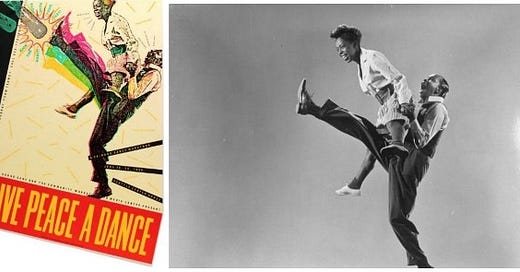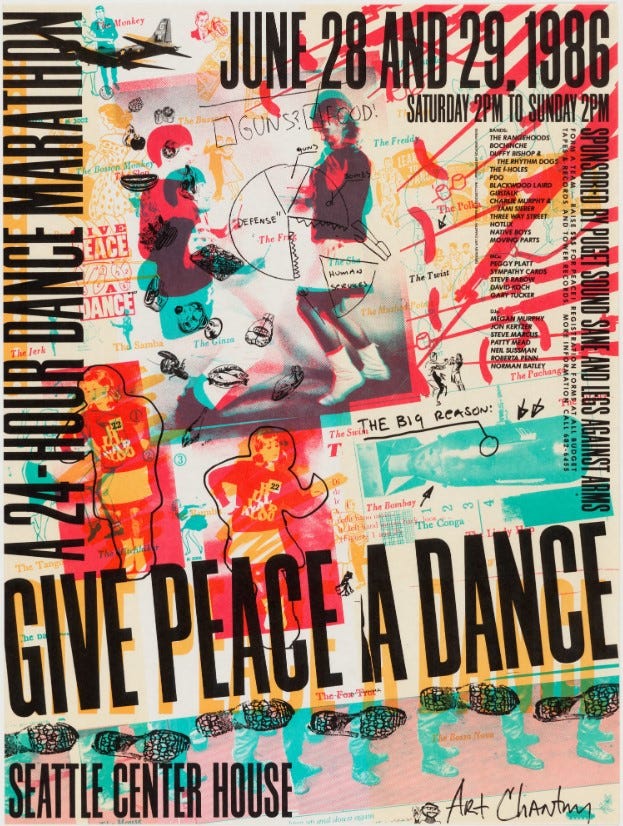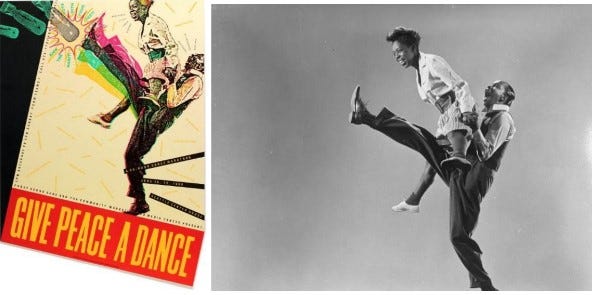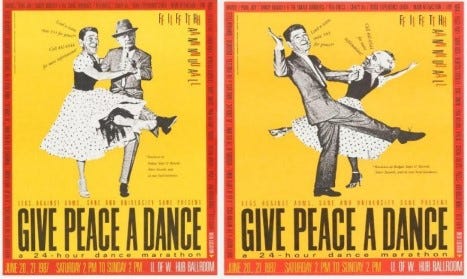Origins of Grunge Design Pt. III : Give Peace a Dance (1988)
Nuclear Freeze movement, Cold War and Art Chantry.
Just as the tool poster used recycled material to form a collage, Give Peace A Dance (1988) series use this same approach to create politicised designs. Art Chantry described that as a graphic designer ‘’we’re quite dangerous in our actions, really. There is great power in our skills’’(Harris, 2019). Chantry`s designs for Give Peace a Dance- a 24-hour dance marathon in Seattle Centre House, motivated to raise funding and to stop the nuclear arms race between the Soviet Union and the United States. Nuclear arms race began with the detonation of atomic bombs in Hiroshima and Nagasaki by American forces in 6th and 9th of August 1945. Gar Alperovitz in 1965 argued that U.S President Harry Truman ‘’used the A-bomb for a diplomatic purpose, nothing could be easier to explain than the use of the second bomb’’ (Yagami, 2009). Fears of nuclear war intensified with the Soviet Union successfully detonating their first nuclear bomb on 29th of August, 1949 in Kazakhstan.
United States tested their first hydrogen bomb in 1952 and a year later, Soviet Union had successfully done the same. In 1957, the Soviet Union tested their first intercontinental ballistic missile which the United States also did the same year. The intensification of international relations and nuclear arms race had become a catalyst for the Cuban Missile Crisis of 1962. The event involved The United States and the Soviet Union to commit to a political and military conflict from 16th-29th October, 1962. This was due to the Soviet Union installing nuclear missiles in Cuba which they refused to remove. The United States could not ignore the fact as such an instalment was done 90 miles from the United States shores. With this said, the Cold War (1947-1991) between the two world powers was not only a geopolitical war, but ideological, considering American war on communism.
Significantly, ‘’radiation was often used in popular culture to signify that the future had arrived’’ (Jacobs, 2010) and such was reflected and established through futuristic designs, futurism and technology advancements in popular culture. As mentioned in previous posts, futurism, consumerism, wealth and the encouragement of capitalism in the 1980s United States popular culture was a reaction to communism. Such had helped to strengthen patriotism and the American identity as a representation of capitalism. In order to showcase opposition to the soviet regime and showcase the benefits of capitalism, such strategy helped to do so, as it contrasted soviet reality. The nuclear disaster at Chernobyl, Ukraine on 26th of April, 1986 ‘’signalled to Moscow and the world just how poor the general condition of Soviet machinery and equipment was, and how outdated USSR technology had become’’ (Xenakis, 2002,p.13). But such disaster had continued fears of nuclear missile strikes in the United States, which resulted in the protest marathon Give Peace A Dance and the Nuclear Freeze movement. It is worth noting that the Nuclear Freeze movement was the largest peace protest in American history and according to a poll in May 1982, American society expressed 72% in support of the movement, 21% against and 7% felt undecided (Warnick and Inch, 1989, p.179).
‘’Give Peace A Dance’’ (1988) poster by Art Chantry for Seattle Centre House, Nuclear Freeze 24h dance marathon (MoMA, 1988)
Chantry`s designs indicate how politicised not only his work was but how important political activism had become for the grunge movement. Chantry`s exemplified poster features a collage of silhouettes of red weapons, campfire skewers with marshmallows and sausages, and guns pointing at dancing teenagers, nuclear missiles, creating a juxtaposition between the innocence of children and guns. This iconography is central for the poster as it suggests that the future (children) will be destroyed if the nuclear arms race continues. The combination of innocence (which the teenagers and the iconography of a camping trip suggests) and nuclear missiles in a collage format makes the poster establish its protest roots, particularly, as collage is the ‘’common vernacular of protest art’’(Lowey and Prince, 2014,p.143). The red tone colour scheme infers violence and blood of weaponry on children and human lives. Such presentation itself is controversial as Chantry is using children as victims. Symbolising the end of childhood and criticism of Republican politics.
‘’Give Peace a Dance’’ Poster by Art Chantry (1988). Poster denotes African American couple dancing The Lindy Hop, whilst kicking the nuclear bomb away. (Lasky, 2001, p.80)
Leon James and Willa Mae Ricker dancing the Lindy Hop, featured in a photo essay in the August 23, 1943, issue of Life magazine. (Mili, 1943) 52
‘’Give Peace A Dance’’ (1986) poster by Art Chantry for Seattle Centre House, Nuclear Freeze 24h dance marathon (MoMA, 1988). Figure 18 is another design from the ‘‘Give Peace A Dance’’(1988) series. It addresses not only international conflicts but domestic issues. Initially, such design was intended to denote a football player kicking ‘’an atom bomb out of the frame with such force that the whole work would be knocked off kilter’’(Lasky, 2001,p.83). However, Give Peace A Dance did not desire to have a football player in their peace poster, which resulted in Chantry to use a photograph of a dancing couple (Lasky, 2001,p.83). Even more significant is the choice to denote an African American couple. Chantry places the African American couple in the position of the hero. Such design suggests that the couple is preventing the atom bomb from reaching the United States. Notably, through the tilted composition of the design which exaggerates the movement and power of the kicking of the atom bomb, as sense of a supernatural power is associated with the couple. Chantry explains that ‘’as far as I know it’s the first time in the history of Seattle that people of colour showed up on a poster…and the client couldn`t object to that’’(Lasky, 2001,p.83). Chantry demonstrates political activism for racial equality, whilst indicating the presence of such an issue in Seattle.
Amy E. Arntson explains that: ‘’art and design both reflect society and help shape it’’ (Arntson, 2011,p.22). And Chantry`s design supports such an argument, as the display of an African American couple promotes inclusion and equality, inferring how important design can be in order to promote political ideas or raise awareness to social injustices. The fact that the couple are dancing in the style of The Lindy Hop, which is a dance originating from the African American communities in Harlem New York, in the 1928, furthermore, acts as activism pro racial equality. The dance style originated from the first believed integrated ballroom – The Savoy in New York City, and is credited for originating the Lindy Hop (Giordano, 2003,p.63). With such symbolism and historical context of the dancers, the design is seeking unification of the American public, by demonstrating inclusivity of the African American communities and their culture. Such work subverts stereotypes and expectations, signifying, the importance of design as a historical indicator of society. Chantry in such design is placing all attention to the couple and giving more importance to them, which would be extremely significant for Seattle as Chantry explains in the fact that such choice was not popular in Seattle. Pat Blashill in our Close Focus (2022) series explains that:
‘’All of us have a subjective opinion… as a photographer or an artist, every choice you make does have some sort of implication. If you chose to photograph white people only-that’s political. If you chose to photograph a black person because you want to show that there’s black people at a punk show-that’s political’’ (Brence, 2022).
Explaining that all choices have political implications. Meaning that design can be considered as a political tool, which advertises a set of beliefs, in Chantry`s case, a strong anti-republican tradition which had been also practised through the musical scene of Seattle, with examples such as Pearl Jam who had supported democratic former President Bill Clinton in his presidential campaign in 1993, as the previous blog posts indicated. Such presentation of the hero alienates the traditional American hero conventions, the ‘’goal-driven hero will be a white, handsome., middle-aged, upper middle-class, heterosexual, protestant, Anglo-Saxon male’’ (Berg, 2002,p.67) in Hollywood productions. Whilst graphic design and film are two different mediums, both are reflective of the society, as Amy E. Arntson had explained.
Hollywood productions illustrate ‘’in some way the character of the society in which it was produced and for which it was designed; it is the most perfect record of one factor operating within and upon that society-itself’’ (Mora, 1989,p.3). This illustrates that both art forms are important indicators of the society, and their individual importance should not be discredited. As well as their thematic and semiotics are both reflective of the American ideological preferences. Manning Marable argues that: ‘’since the election of Ronald Reagan in 1980, in presidential contests the Republican party operates almost like a white united front, dominated by the most racial, reactionary sectors of corporate and finance capital, and the most backward cultural and religious movements’’(Bowser and Hunt, 1996,p.66). In the 1980s, the Evangelical Right had gained momentum and Moral Majority – a Conservative Christian organisation had been founded in 1979 by Jerry Falwell.
Moral Majority`s executive director Robert Billings was Ronald Reagan's campaign adviser. It is worth noting that Ronald Reagan had appointed individuals with Religious Right`s ideology, as example ‘’Dr C. Everett Koop, an active opponent of abortion rights, was nominated surgeon general. Robert Billings, who founded the National Christian Action Coalition, as named undersecretary of education, while William Bennett, a staunch supporter of social conservatives` views on education, was appointed to chair the National Endowment for the Humanities. In 1985, moreover, Bennet was named as Reagan`s secretary of education’’ (Johns, 2015,p.595). Chantry`s subversion of the traditional American hero, can be viewed as a protest against the 1980s republicanism, as he is challenging the white supremacy ideology which Manning Marable had identified in the 80s republican party.
Considering Marable`s link between the Republican party and televangelist Jerry Falwell's Moral Majority, the protest against televangelists in Tartuffe (1983) is a protest against Republicans. It is important to note that Art Chantry had expressed that ‘’the left wing needs to find a way to reclaim the American flag’’ (Lasky, 2001,pp.103-104). Likewise, Kurt Cobain, as mentioned earlier, was anti-Republican. The leading figure in the Seattle music scene had expressed his lack of desire to play clubs, because he ‘’would like to get rid of the homophobes, sexists, and racists in our audience…I know they're out there and it really bothers me"(Schinder and Schwartz, 2008, p.604). Indicating more social injustices present in the American society which grunge, through its design tried to protest. Manning Marble`s description of the Republican party, does not positively portray such politics and its figures, furthermore, giving insight on the reason behind the anti-republican agenda within the hardcore punk and grunge movements. As mentioned before, the fact that there had not been a design in Seattle displaying an African American couple, indicates how politicised Chantry`s work is. As well as how limited racial representation was in Seattle, further, suggesting how American mainstream media had stigmatised a part of the American society and the American identity.
‘’Give Peace a Dance’’ Posters by Art Chantry (1988) (Lasky, Chantry,2001, p.80)
When considering that Chantry`s discussed design was created for a political movement (Nuclear Freeze) which had gained great power in America, his work indicates a change in the American Society. Especially when considering that after a decade of republican domination (1981-1992), Democrat President Bill Clinton in 1993, was able to claim a victory in the presidential election for two terms. Chantry’s work challenges conservative politicians, as example, in the most politically provoking designs (figure 20), showcasing, 80s USSR leader Mikhail Gorbachev and former US president Ronald Reagan dancing polka. When considering the grunge scene’s protest against Republicans, this example of Chantry`s designs is the most politically confrontational. Whilst the female body with the dress can be perceived as ridicule of Gorbachev and Reagan, the switching of the dresses between the leaders, does not position the design as patriotic. Furthermore, portraying the leaders in a controversial manner, which does not support conservative gender roles.
Chantry recalls that: ‘’at first everyone noticed and wanted the Reagan-in-drag one, but as the Eastern bloc broke up, ‘’Gorby drag’’ became big. Then as Gorby`s popularity faded, ‘’Ronnie drag’’ became the one everyone remembered’’(Lasky, 2001,p.82-83). Giving a sense of anti-authority and rebellion as such design does not support one of the leaders. Criticising in a depreciative and comedic way, it removes authority and power associated with these politicians, despite the fact that nuclear arms race was present in the Cold War (1947-1991). Furthermore, the central framing of the cut-out, black and white politicians in a red border, makes the spectator focus on such figures. Possibly, associating the politics of these powers to cause the death of childhood and violence presented in the previous poster (figure 18). The black and white cut outs of the political leaders, suggests old newspapers, inferring that their politics and values have been outdated.
The recycling aspect with the work itself being a collage is indicative of the political protest that Chantry has continuously expressed, particularly in domestic politics against republican politics and Ronald Reagan. He is inferring their failure and lack of suitability for the American public, when considering the great support of 72% of the Nuclear Freeze movement. However, such position of the leaders had culminated great appraisal, as such designs toured the Soviet bloc and Nicaragua, as well as for the first time since the blockade- Cuba. But ‘’the greatest compliment was paid by the president of Ukraine, who visited his studio to secure autographed copies’’ (Lasky, 2001, p.83). Such high appraisal and recognition from the Ukrainian President, highlights, Grant Alden`s observation. Grant Alden observed about Chantry that he ‘’is the chronic advocate for the unpopular position, and he approaches graphic design as if he were a political fine artist’’ (Lasky, 2001, p.103). As well as the fact that Chantry represents the unpopular opinion, becoming a dissident when considering how popular Ronald Reagan was in the American society in the 70's and 80s, as he was re-elected for a second term in 1984.
What can we say, Chantry is beyond cool.
Reading daily exercises the brain, improves sleep and reduces stress, so why not read some more?! Check this out:
West Coast Hardcore Punk & Grunge: Protest Against Police, Religion and Reagan
There's always room for jello – slogan for Jello Biafra's campaign (real name Eric Reed Boucher) (Bickel, 2015) As previously discussed in Every Single Sound Speaks In The Plural: West Coast hardcore punk and grunge , the hardcore punk movement was a rebellion movement against the political social fabric that it existed in.









